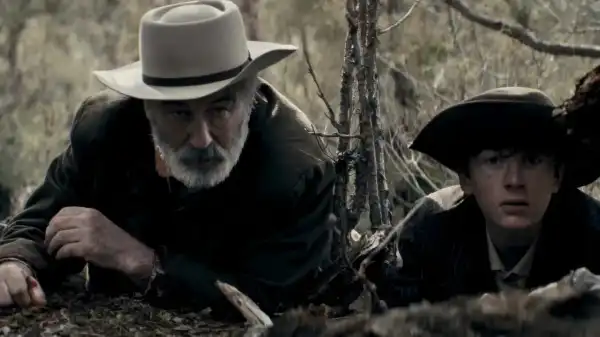
Save this storySave this storySave this storySave this story
Some films become inextricably linked to the stories of their making. Alfred Hitchcock’s The Birds and Marnie are now inextricably linked to allegations that their star, Tippi Hedren, was mistreated by the director. Others are associated with their backstories even before they’re released, whether it’s Michael Cimino’s protracted shoot and bloated budget for Heaven’s Gate or Francis Ford Coppola’s audacious self-financing for Megalopolis. Joel Souza’s Western Rust falls into the latter category for a far more serious reason: While filming in New Mexico in 2021, its star and co-producer Alec Baldwin was given a gun that, unbeknownst to him, contained live ammunition. While rehearsing a shootout scene, he accidentally shot cameraman Galina Hutchins, killing her. The bullet pierced her and wounded Souza. Baldwin and the film’s gunsmith, Hannah Gutierrez-Reed, faced manslaughter charges. The charges against Baldwin were eventually dropped on procedural grounds. Gutierrez-Reed was found guilty and sentenced to eighteen months in prison. First assistant director David Halls pleaded guilty to a misdemeanor charge of reckless use of a deadly weapon.
At the time, reading reports of the horrific incident—along with reports of unsafe practices on set, due in part to a limited budget—I assumed the film would never be completed. But filming resumed in Montana in 2023 with a new cinematographer, Bianca Cline. In the meantime, Souza had reworked the script, removing the scene—set in the church where the shooting occurred. Some of the actors were no longer available; their roles were recast and scenes were rewritten; in one case, an actor’s face was digitally superimposed onto previously shot footage. Souza claimed to be completing the film at the request of Hutchins’s family, saying his goal was “simply to honor her last work” as a tribute to Hutchins and a showcase for her craft, as well as for the financial benefit of her family. (As part of the agreement, Hutchins’s widower, Matthew, was named an executive producer on the film.) The film has now been completed and released both theatrically and on streaming services. For me, at least, it’s impossible to watch it without being reminded of its murky production history. On the other hand, I don’t think that knowledge affects my perception of its artistic value, except to the extent that its complex genesis seems to influence the results.
Based on a screenplay by Souza, who co-wrote the story with Baldwin, Rust is set in 1882. The plot begins in Wyoming, where two orphaned Hollister brothers, Lucas (Patrick Scott McDermott) and Jacob (Easton Malcolm), live in their late parents’ farmhouse. Lucas, thirteen, tries to care for Jacob, who is about half his age, but has difficulty. They travel to a nearby town, where Lucas sells cattle to buy provisions. At a general store, Lucas gets into a fight and injures a boy who is teasing Jacob. The next day, the boy’s father, Charles Gantry (Gabriel Clark), arrives to demand that Lucas take the boy’s place on his ranch; the next day, Lucas shoots a wolf and accidentally kills Gantry, whom he did not notice as it approached. Lucas is arrested, convicted of murder, and sentenced to hang. But he is rescued from prison by a criminal named Harland Rust (Baldwin), who turns out to be his estranged grandfather. Rust intends to smuggle the boy to Mexico, where a trusted friend and a place at a school await him, and their gritty fugitive journey is as much a drama of mentorship and coming-of-age as it is a sentimental tale of family ties. But bounty hunters learn of the escape—Rust is a long-wanted fugitive—and give chase. Violence erupts, both between pursuers and pursued, and among the hunters themselves, who compete for the reward.
Despite, or perhaps because of, the gritty melodramatic clarity of the plot—a deep interest in saving a child from injustice, a criminal with a heart of gold risking his life to take on that responsibility—Rust is a painfully routine, almost inert experience. The narrative is sluggish, not because the film’s physical pace is slow, but because its mental pace is methodical and academic. The characters are so literally constructed, with traits that either directly motivate the action or are merely decorative, that the actors might as well be wearing Post-it notes. The film’s exposition dispenses with the overwhelming obviousness, and while Souza takes pains to make backstory appear mid-action, here too the actors seem to be waving pallets marked “Backstory, attention.”
Souza no
Sourse: newyorker.com